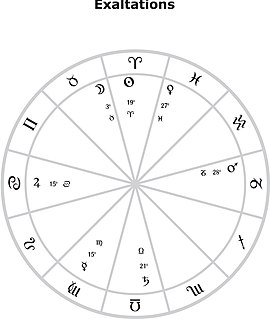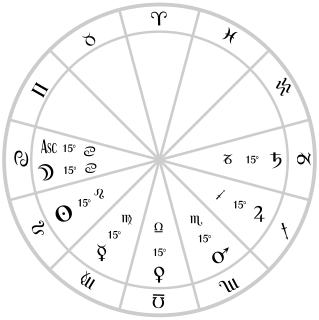Related Research Articles

Western astrology is the system of astrology most popular in Western countries. Western astrology is historically based on Ptolemy's Tetrabiblos, which in turn was a continuation of Hellenistic and ultimately Babylonian traditions.

In astrology, an aspect is an angle that planets make to each other in the Horoscope; as well as to the Ascendant, Midheaven, Descendant, Lower Midheaven, and other points of astrological interest. As viewed from Earth, aspects are measured by the angular distance in degrees and minutes of ecliptic longitude between two points. According to astrological tradition, they indicate the timing of transitions and developmental changes in the lives of people and affairs relative to the Earth.

The ascendant is the astrological sign that is ascending on the eastern horizon at the specific time and location of an event.

In Western astrology, astrological signs are the twelve 30 degree sectors that make up Earth's 360 degree orbit around the Sun. The signs enumerate from the first day of spring known as the First Point of Aries which is the vernal equinox. The Western astrological signs are Aries, Taurus, Gemini, Cancer, Leo, Virgo, Libra, Scorpio, Sagittarius, Capricorn, Aquarius and Pisces. The Western zodiac originated in Babylonian astrology, and was later influenced by Hellenistic culture. Each sign was named after a constellation the sun annually moved through while crossing the sky. This observation is emphasized in the simplified and popular sun sign astrology. Over the centuries, Western astrology's zodiacal divisions have shifted out of alignment with the constellations they were named after by axial precession while Hindu astrology measurements correct for shifting.Astrology has developed in Chinese and Tibetan cultures as well.
The Harmonic Convergence is the name given to the world's first synchronized global peace meditation, which occurred on August 16–17, 1987. This event also closely coincided with an exceptional alignment of planets in the Solar System.

Natal Astrology is also known as Genethliacal Astrology, which implies nativity. It is a system of Astrology that claims to shed light on an individual’s personality or path in life. This concept is based on constructing a Horoscope or Natal Chart that includes the exact date, time, and location of an individual's birth. Natal Astrology is found in the Indian or Jyotisha, Chinese and Western astrological traditions.

Astrology has used the concept of classical elements from antiquity up until the present. In Western astrology and Sidereal astrology four elements are used: Fire, Earth, Air, and Water.

In astrology, exaltation is one of the five essential dignities of a planet. The exaltation is a place of awareness for the planet, whereas the fall is a position of weakness concerning the function of the planet. The sign position directly opposite a planet's sign of exaltation is considered to be its fall.

Essential dignity, in astrology, refers to the relative strength or weakness of a planet or point's zodiac position by sign and degree, or its essence—what the 17th-century astrologer William Lilly called "the strength, fortitude or debility of the Planets [or] significators." In other words, essential dignity seeks to view the strengths of a planet or point as though it were isolated from other factors in the sky of the natal chart.

In astrology a planet's domicile is the zodiac sign over which it has rulership. This is a separate concept from the houses of the horoscope. A planetary ruler is given to each sign, over which the planet is said to have a more powerful influence when positioned therein. The ruling planet associated with a sign is also used as an implied focus of interpretation for the signs on house cusps in a chart. A planet is considered to be in domal dignity when it is positioned in the sign it rules. This is the strongest of the five essential dignities of a planet.
In astrology, a triplicity is a group of three signs belonging to the same element.
In astrology, mutual reception is when two planets are in each other's signs of rulership. Mutual Reception Two planets are in mutual reception when they are in each other's signs. If the condition of each planet in mutual reception is strong, they will strengthen and provide assistance to one another. Some modern astrologers believe they will also take on some of each other's attributes.

Astrological transits are one of the main means used in horoscopic astrology to forecast future trends and developments. As its name implies, astrological transits involve a method of interpreting the ongoing movement of the planets as they transit the horoscope. This is most often done for the birth or Natal Chart of a particular individual. Particular attention is paid to changes of sign, or house, and to the aspects or angles the transiting planets make with the natal chart.

Sect is an ancient astrological concept in which the seven traditional "planets" are assigned to two different categories: diurnal or nocturnal sect.

Historically, astrological and astronomical symbols overlapped. Frequently used symbols include signs of the zodiac and classical planets. These originate from medieval Byzantine codices. Their current form is a product of the European Renaissance. Other symbols for astrological aspects are used in various astrological traditions.

The Thema Mundi was a mythical horoscope used in Hellenistic astrology that shows the supposed positions of the seven visible planets at the beginning of the universe. It purports to exemplify the logic behind the sign rulerships, exaltations, and meanings of the aspects, among other things. The purely symbolic nature of the chart is readily perceived from the impossible positions of Venus and Mercury in it. In the late Middle Ages there has been a confusion between a horoscope of the world and the thema mundi.

Planets in astrology have a meaning different from the astronomical understanding of what a planet is. Before the age of telescopes, the night sky was thought to consist of two very similar components: fixed stars, which remained motionless in relation to each other, and "wandering stars", which moved relative to the fixed stars over the course of the year.
Planetary aspects are interchange of energies at great distances; the respective mass of each planet generates and radiates its own specific energy-field. At times these planetary aspects take a lead over planetary conjunctions. Planetary aspects play an important role in predicting future events. However, there are three great differences between Western astrology and Hindu astrology in computing these aspects - (1) in the former system the count is made from degree to degree, in the latter system the count is made from sign to sign, (2) in the former system the aspect will be mutually the same i.e. if Mars and Jupiter are in trine it can be expressed as either Mars Trine Jupiter or Jupiter Trine Mars, in the latter system if Jupiter is in Aries and Mars in Leo, Jupiter will have full aspect on Mars but Mars will have 50% aspect on Jupiter and, (3) in the former system certain aspects such as sextile are good whereas square and opposition are evil, the latter system does not have such classification in which system aspects by benefic planets and those owning trines i.e. the 5th and the 9th, are always good, and by malefic planets and those owning cadent houses i.e. the 6th, 8th or 12th, are always evil; moreover, the aspect of any planet on its own sign strengthens that house and causes no harm to its indications.
Planetary Stock Trading is a book written by a financial astrologer and fund manager Bill Meridian. It is a manual on how to spot stock market winners by their first trade horoscopes and their astrological transits. Meridian makes use of several concepts in the book which are not common in traditional astrology, including the use of declinations, the inclusion of asteroids and hypothetical planets, and the study of first trade charts instead of incorporation charts.
References
- ↑ "The Mountain Astrologer Planet Tracks Neptune Pluto".
- ↑ "An Alignment for Our Times: 2010". www.astrologyforthesoul.com. Archived from the original on 2004-04-04.